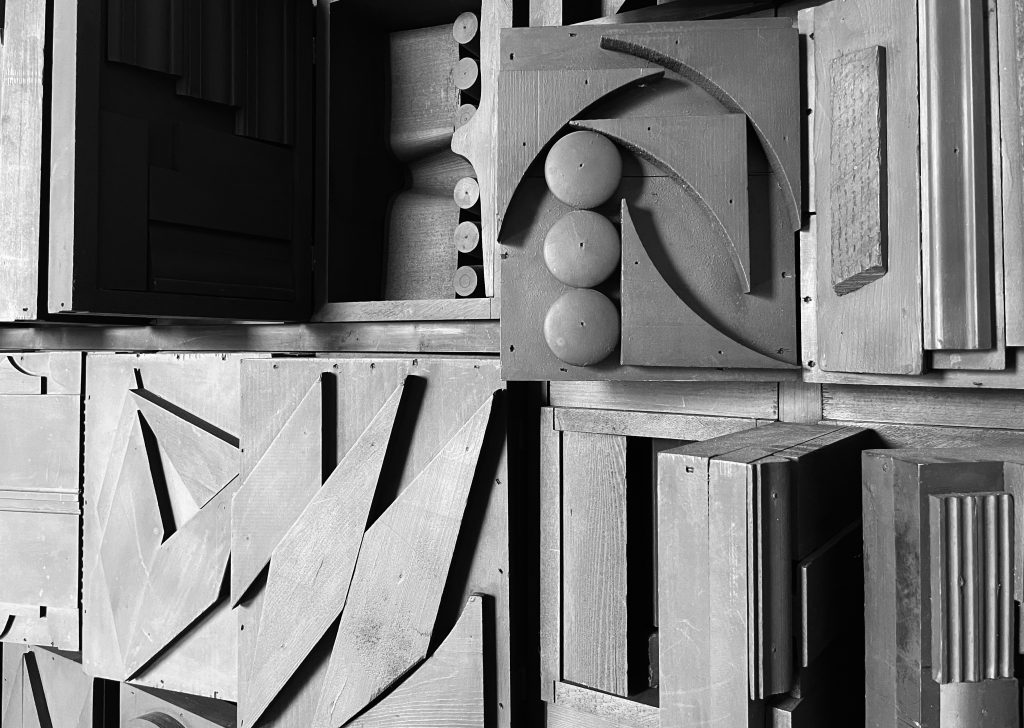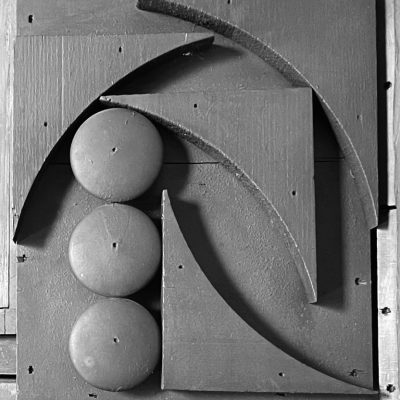
Black Secret Wall
Louise Nevelson

The exhibition aims to delineate a pathway towards the understanding of the poetics of Louise Nevelson (Kiev, 1899 – New York, 1988) with a refined selection of collages dating from the 1950s until the 1980s together with a massive black wooden piece that carries with it the history of who created it, who sold it and who later welcomed and cherished it for almost half a century.
The show is an historical narration beginning from the artist’s most intimate concept, which generated the collages as a constant practice of spontaneous, self-aware and indispensable expression of her creative process over the course of her entire career, for the production of more physically sculptural works such as the colossal Black Secret Wall as well, the culmination of this visual journey.
A quiet and private viewing scanned by the rhythm of the calculated proportional harmony that is rooted in the seventeenth-century architecture of the Villa Ca’Amata and in the organic perfection of its surrounding nature, while discovering one of the greatest artists of the XX century.
25th April – 25th May – 25th June – 11 am
The screening of a documentary about Louise Nevelson will be followed by a spontaneous conversation with the guests during an aperitivo in the gardens, meant as an engaging occasion to broaden the knowledge of the artist’s work and the historical context in which it was developed.
A project of cultural promulgation curated by ATXX – CA’AMATA
booking required – limited seats
The entry is free and the aperitivo is pleasantly offered to those who will choose to devote their time to the examination of the cultural aspects that characterized the XX century.
Contacts: art@allegraravizza.com | Tel: +41 (0)789760926
Ca’Amata – via Loreggia di Salvarosa 44 – Castelfranco Veneto – Italia
www.caamata.com | www.allegraravizza.com
As an emblematic figure of Twentieth-century art, Louise Nevelson distinguished herself in the international art scene through her search for a universal language.
Nevelson gave the found objects that make up her abstract sculptures “a new spiritual life” different from their original one. She did this by subjecting them to a preparatory ritual, as though decontaminating them from the effects of the outside world.
Monumentality, monochrome and the dislocation of planes on a shallow depth are distinctive features of her assemblages or “environments”.
Louise Nevelson (Leah Berliawsky) was born in Kiev in 1899. At the age of six she immigrated with her family to the United States. Louise spent her childhood in Rockland (Maine), where she showed an early penchant for art. With her husband Charles Nevelson, a naturalised American born in Riga, in 1920 she settled in New York, where she studied music and theatre and visited avant-garde galleries.
In 1929 she enrolled at the Art Student’s League and in 1931 she travelled to Germany to take classes with Hans Hofmann. A few months later she travelled to Italy and Paris, where she visited the Musée de l’Homme, becoming fascinated with the African art on show there, and with the Cubist artworks she saw in the city’s galleries. Once back in New York, she began to assist Diego Rivera in the decoration of the RCA Building and the New Workers’ School.
In 1933 she rented a studio space in Greenwich Village and began exhibiting her own works, mainly primitivist sculptures made from found objects and natural materials.
In 1935 she took part in Sculpture: A Group Exhibition by Young Sculptors, organised at the Brooklyn Museum of Art, and in the following years she showed her work in several group shows.
In September 1941 she had her first solo show at the Nierendorf Gallery, followed by another the next year. During these years she met many key figures of European contemporary art who had sought refuge in America after the outbreak of World War II. At Duchamp’s suggestion, in 1943 Peggy Guggenheim’s gallery, The Art of This Century, organised a women-only show entitled Thirty-One Women, in which Nevelson showed an all-wood piece entitled Column.
From the mid-Forties on, her works were exhibited almost every year at the Whitney Museum. From 1954 she organised a cycle of exhibitions at the Grand Central Modern Gallery, and major American museums began purchasing her works.
In 1959 she took part in the important exhibition Sixteen Americans, showing her room-size installation Dawn’s Wedding Feast, her first white sculptures, composed of large-scale works that entirely covered the walls, and with central columns symbolising the sun and moon.
In 1962 she was invited to take part in the Venice Biennial, and in 1964 she attended the Documenta in Kassel. In 1967 the Whitney Museum held a major retrospective of her work.
From the end of the Sixties she participated in numerous exhibitions all over the world, earning significant critical recognition and several awards.
She created monumental works, such as the Chapel of the Good Shepherd for the Lutheran Church of St. Peter in New York (1977) and the sculpture Sky Gate – New York for the World Trade Center (1978).
In 1973 at Studio Marconi in Milan, Nevelson personally opened a show of eighty pieces of her work dating from 1955 to 1972, marking the start of a close, life-long collaboration with the gallery.
To mark her 80th birthday, the Whitney Museum mounted a retrospective entitled Atmospheres and Environments, with installations spanning from 1955 to 1961.
In 1980, the Phoenix Art Museum organised a vast traveling retrospective entitled The Fourth Dimension.
Louise Nevelson died in New York on 17 April 1988.
Among the numerous retrospectives devoted to Nevelson was one organised in April 2014 by the Fondazione Roma in collaboration with the Marconi Foundation, another was held in Catania at the Puglisi Cosentino Foundation, also in 2014, both curated by Bruno Corà; and a third in the same year at Die Galerie, Frankfurt am Main. In 2016 the Marconi Foundation presented an exhibition displaying a selection of sculptures and collages, that was followed in 2017 by a solo show held at the Moderna Museet in Stockholm and the exhibition “Louise Nevelson – Sculptor of Shadows” at the Kunsten in Aalborg in 2020.
